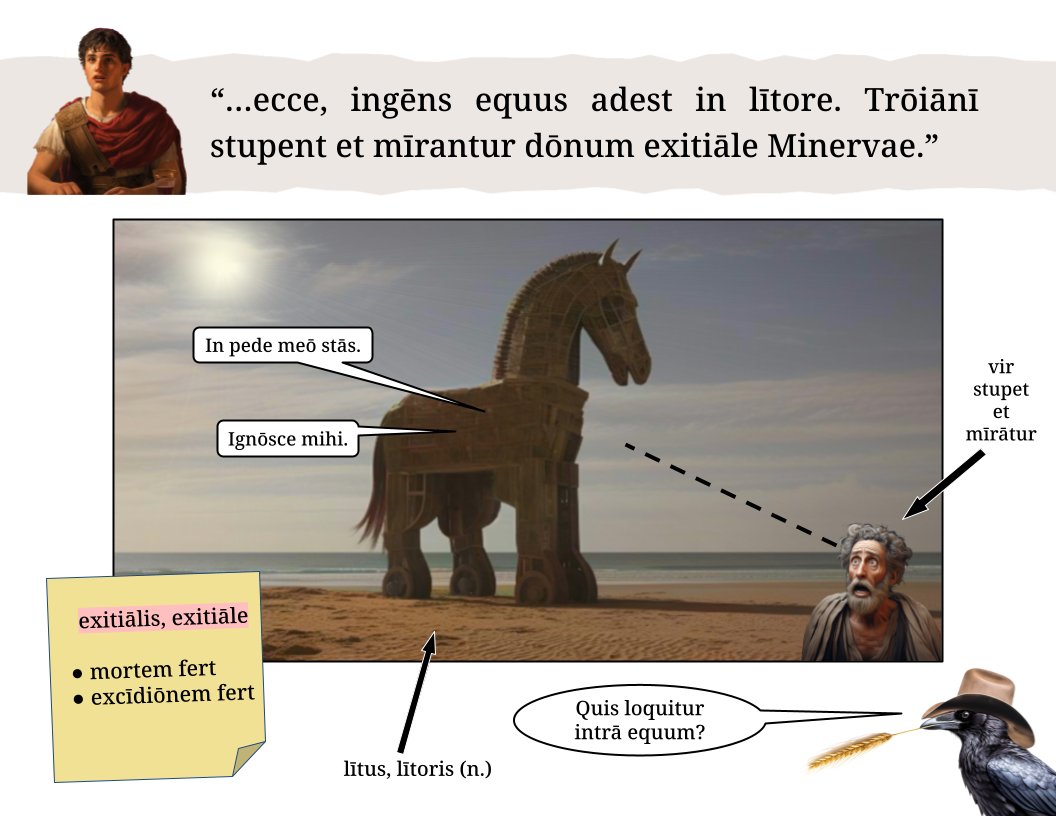

Resources for Speaking Latin
Speaking Latin is an extremely effective learning method. This page provides links and resources designed to help you speak Latin.
There are four basic ways to experience a language:
- Reading
- Writing
- Speaking
- Listening
If you only read Latin, your experience with the language is limited to just one of these four ways. But if you actively use Latin—listening to, speaking, and writing it—you will have a much richer experience. This makes learning Latin faster, more effective, and more fun!
Bulletin Board Readings
These specially-designed readings help students and teachers to engage with Latin actively. They are in a slideshow format. Each slide contains only a small amount of Latin text at the top. In the lower part of each slide, there are explanatory materials—including pictures, diagrams, labels, and sticky notes (hence the name “Bulletin Board” reading). The diagrams, explanations, and labels are all in Latin, with no English whatsoever. This design is inspired by Hans Ørberg's Latin materials, but with less text per page and many more illustrations/captions (think “Ørberg on steroids”). Here's an example of what a typical slide looks like.

The pictures and diagrams explain potential difficulties in the text while offering plenty of material to discuss in Latin. Certain pictures show what Latin words mean. Sticky notes provide definitions, explain grammar, or show the different forms of a word. If one of the characters in the reading is saying the words at the top of the slide, that character's picture appears in the upper left hand corner as a visual cue to help the user keep track of the plot. A bird named Torvus the corvus (corvus means “raven” in Latin) sits in the lower right-hand corner. Torvus asks questions and makes silly comments while trying to get involved in the action.
The bulletin board readings are designed primarily to facilitate Latin conversations, but they can be employed in multiple ways. Here is a list of some possible uses for the bulletin board readings.
- Zoom Meeting Latin Chats: In a Zoom meeting, one participant can display the slideshow using the “share screen” feature. Attendees can then read the main text at the top aloud, discuss the text in Latin, ask questions in Latin, and use the various pictures and diagrams as prompts for Latin conversation. A more experienced Latinist can serve as the host, guiding the conversation by posing certain questions and/or explaining things in Latin.
- In-person Latin Chats: In an in-person chat, participants can view the readings as a projected image on a screen, or on their own personal devices. Alternatively, the slides can be printed and distributed, since they are formatted for letter-sized paper (landscape view).
- Personal Study: A student can use the reading for individual study, since the pictures and diagrams help with comprehension.
- Grammar-Translation Teaching: Although the bulletin board readings were designed for a spoken Latin environment, they still can be used in a non-immersion classroom. The reading can be displayed on a large screen while the teacher helps the students work through the reading. For classes moving from grammar-translation to spoken Latin, these readings can facilitate that change. Once the class is familiar with the vocabulary and grammar in the reading, they can easily pivot to participate in a Latin-only discussion.
